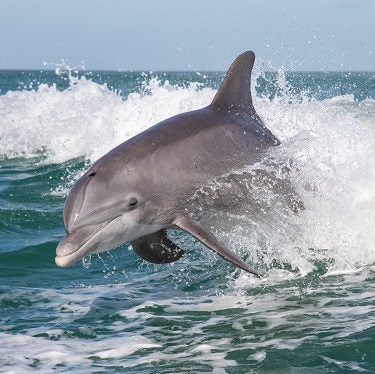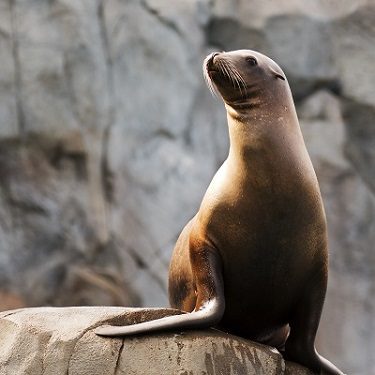Marine Life Encyclopedia
Sharks & Rays
Basking Shark
Cetorhinus maximus
Distribution
Worldwide in warm to cold temperate latitudes; absent from the tropics
eCOSYSTEM/HABITAT
Coastal to open ocean (pelagic)
FEEDING HABITS
Filter feeder
TAXONOMY
Order Lamniformes (mackerel sharks and relatives), Family Cetorhinidae (basking sharks)
The basking shark is the second largest fish in the world, and like the largest fish (the whale shark) and the largest animal (the blue whale), basking sharks are filter feeders that eat tiny, planktonic prey. Reaching lengths of 40 feet (12 m) and resembling predatory sharks in appearance, the basking shark can give an intimidating impression, but they are quite harmless. They spend most of their time near the surface, swimming with their extraordinarily large mouths open, filtering out their preferred prey, but they may also make deeper, feeding dives.
Though they are quite large, there are gaps in scientists’ knowledge of their life history characteristics because they have very large individual home ranges and do not stay in any one place for longer than a couple of months. Pairs of basking sharks mate via internal fertilization, and females give birth to live young. As opposed to whale sharks, which give live birth to hundreds of small babies, basking sharks give birth to only a few, quite large babies. Based on the minimum size of individuals observed in the wild (6 feet/2 m) and a single pregnant individual caught by a fisher, shark biologists believe that basking sharks give birth to the largest babies of all fishes, just beating out the great white shark. Furthermore, scientists believe that male and female basking sharks live at different places and likely only come together to mate and that pregnant females (almost never encountered by fishers or other people) separate from other females during gestation. Nearly every individual that is caught near the surface is a female that is not pregnant.
The basking shark is one of a few species that lives in temperate latitudes, both north and south of the equator, but not between these two zones in the tropics. However, scientists believe that the individuals in these two zones are all the same species, so it is likely that at least some individuals (perhaps males) that spend part of the year in the deep sea move back and forth between the two hemispheres without ever coming to the surface. Throughout some parts of their range (e.g., both coasts of North America), basking sharks are uncommon and solitary, but during some seasons and places (e.g., the UK in the summer), they can be fairly common and form large groups.
After centuries of targeted fishing around Europe, the basking shark is considered vulnerable to extinction. While several countries have given them some or complete legal protection, legal fisheries still exist in other places, and occasionally, basking sharks are captured unintentionally in other fisheries. Shark scientists still have much work to do in order to find out more information about the life history, biology, and ecology of these giant fish.
Fun Facts About Basking Sharks
1. Basking sharks are the second largest fish in the ocean, growing to a maximum length of 45 feet (15.2 m)1 and weight of 10,000 pounds (4.5 metric tons).
2. Basking sharks have been observed leaping out of the water, which may be a way of getting rid of parasites.
3. Basking sharks have massive livers that make up 25 percent of their body weight.
4. Basking sharks filter up to 4,000,000 pounds (1814 metric tons) of water every hour while filter feeding.
5. Basking sharks often swim in pairs or large groups of up to 100 other individuals.2
6. Female basking sharks have a gestation period of at least 3 years.
7. It is estimated that basking sharks live for about 50 years.3
Resources:
1 NOAA Southwest Fisheries Science Center
Get Involved

Donate Today
SUPPORT OUR WORK TO PROTECT THE OCEANS BY GIVING TODAY
With the support of more than 1 million activists like you, we have already protected nearly 4 million square miles of ocean.

TAKE ACTION NOW
Support policy change for the oceans
Decision-makers need to hear from ocean lovers like you. Make your voice heard!

VISIT OUR ADOPTION CENTER
SYMBOLICALLY ADOPT AN ANIMAL TODAY
Visit our online store to see all the ocean animals you can symbolically adopt, either for yourself or as a gift for someone else.

DOWNLOAD OCEAN ACTIVITIES
HELP KIDS DISCOVER OUR BLUE PLANET
Our free KELP (Kids Environmental Lesson Plans) empower children to learn about and protect our oceans!



